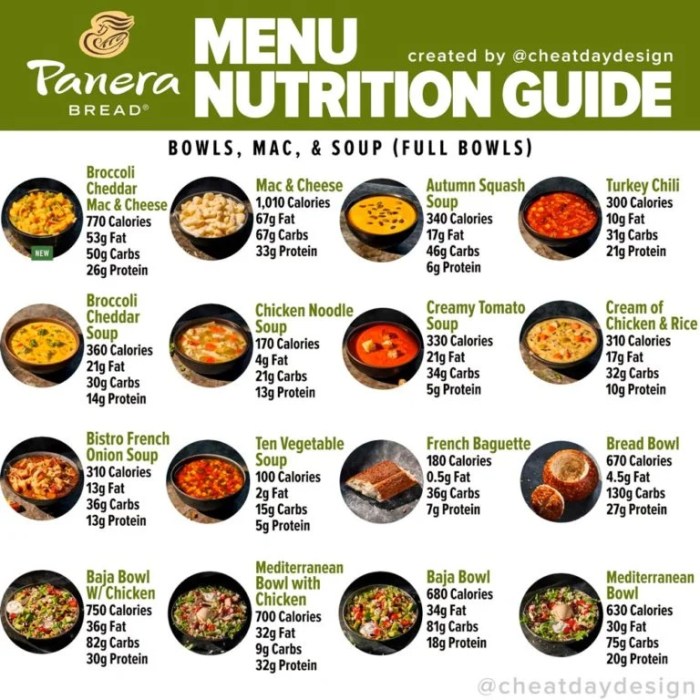
Comparison to Homemade Broccoli Cheese Soup

Broccoli cheese soup panera nutrition facts – Panera Bread’s Broccoli Cheese Soup is a popular choice, but how does it stack up against a homemade version? This comparison delves into nutritional differences, ingredient quality, preparation methods, and cost considerations. We’ll examine the potential trade-offs between convenience and control when choosing between restaurant and homemade options.
A direct nutritional comparison is challenging due to variations in homemade recipes. However, we can analyze general trends. Panera’s nutritional information is readily available online, providing a baseline for comparison. Homemade versions will vary greatly depending on ingredients and recipe.
Nutritional Differences
| Nutrient | Panera’s Broccoli Cheese Soup (per serving, approximate) | Typical Homemade Broccoli Cheese Soup (per serving, approximate) |
|---|---|---|
| Calories | 250-350 | 200-400 (highly variable) |
| Fat | 10-15g | 5-20g (depending on cheese and milk type) |
| Sodium | 600-800mg | 200-600mg (depending on ingredients and salt added) |
| Protein | 8-12g | 6-15g (depending on cheese and milk type) |
| Carbohydrates | 30-40g | 25-45g (depending on the amount of potatoes or other starch added) |
Note: These values are estimates and can vary based on serving size and specific recipe variations for both Panera’s soup and homemade versions. Always check the most up-to-date nutritional information from Panera Bread.
Yo, so you’re checking out Panera’s broccoli cheese soup nutrition facts? That’s pretty legit, but for a healthier side, maybe consider some fruit? Check out the nutritional breakdown for black grapes nutrition facts 100g to compare. Anyway, back to that creamy broccoli cheese soup – gotta balance those calories somehow, right?
Ingredient Quality and Preparation Methods
Panera Bread likely uses standardized, pre-portioned ingredients for consistency. Their broccoli might be frozen, and their cheese blend probably consists of several types for a specific flavor profile. Their preparation methods are likely optimized for speed and large-scale production, potentially involving industrial-sized equipment.
Homemade broccoli cheese soup, on the other hand, allows for greater control over ingredient quality. You can choose fresh, organic broccoli and high-quality cheeses. Preparation is often more involved, requiring chopping, sautéing, and simmering, leading to a potentially richer and more nuanced flavor profile.
Cost Comparison, Broccoli cheese soup panera nutrition facts
The cost of purchasing Panera’s Broccoli Cheese Soup versus making it at home depends on several factors including location, ingredients costs, and recipe complexity. A single serving from Panera might cost $8-$12. Making it at home, using relatively inexpensive ingredients, could cost $3-$5 per serving, though this can increase significantly with higher-quality ingredients.
For example, a family of four might save $20-$40 by making a large batch of homemade soup compared to buying four individual servings at Panera. However, this needs to be weighed against the time investment required for making the soup from scratch.
Dietary Considerations and Modifications

Panera’s Broccoli Cheese Soup, while delicious, may not suit everyone’s dietary needs. This section explores modifications to make it more inclusive and adaptable to various dietary restrictions and preferences. We’ll examine adjustments for sodium reduction, vegetarian/vegan adaptations, and the impact of adding different ingredients.
Low-Sodium Broccoli Cheese Soup Adaptation
Reducing sodium in Panera’s Broccoli Cheese Soup requires careful ingredient substitution. The high sodium content likely comes from the cheese, broth, and seasonings. To lower the sodium, use reduced-sodium or no-salt-added broth and cheese. Instead of relying heavily on salt for flavor, experiment with herbs and spices like garlic powder, onion powder, black pepper, and a pinch of nutmeg.
These additions enhance the soup’s flavor profile without significantly increasing sodium levels. Consider using fresh herbs like parsley or chives for added freshness and a boost of flavor. This modified recipe will significantly reduce the sodium content, making it a healthier option for those watching their sodium intake. A comparison of nutritional labels between the original and modified recipes would highlight the difference in sodium content.
For example, a reduction from 800mg to 400mg of sodium per serving would be a significant improvement.
Vegetarian and Vegan Adaptations
Panera’s recipe likely contains dairy and potentially other animal products. For a vegetarian version, ensure the broth used is vegetarian-friendly. The cheese is the main hurdle; a good substitute would be a reduced-sodium vegetarian cheddar cheese or a blend of nutritional yeast and other vegan cheeses to mimic the creamy texture and cheesy flavor. For a vegan version, replace the dairy cheese entirely with a plant-based alternative like cashew cream cheese or a blend of vegan cheeses.
Ensure the broth is vegan-friendly and check all seasonings for any animal-derived ingredients. Experimentation with different vegan cheeses may be necessary to achieve a similar flavor and texture.
Impact of Adding Different Vegetables and Proteins
Adding different vegetables or proteins to the soup can alter its nutritional profile. Adding vegetables like carrots, cauliflower, or spinach increases the fiber and vitamin content. Carrots contribute beta-carotene, while spinach offers iron and folate. However, adding too many vegetables might dilute the soup’s flavor or create an imbalance in texture. Adding protein, such as cooked chicken or beans, boosts the protein content and adds satiety.
Chicken adds lean protein and some essential vitamins and minerals. Beans offer fiber, protein, and various micronutrients. However, adding protein can also increase the overall calorie count. The nutritional benefits and drawbacks will depend on the specific ingredients added and their quantities. For instance, adding a cup of cooked chicken breast might add around 150 calories and 30g of protein, while a half-cup of lentils might add around 100 calories and 8g of protein.
Careful consideration of the added ingredients and their impact on the overall nutritional balance is crucial.
FAQ: Broccoli Cheese Soup Panera Nutrition Facts
Is Panera’s broccoli cheese soup gluten-free?
No, Panera’s broccoli cheese soup is not naturally gluten-free. Check Panera’s website or inquire directly for the most up-to-date allergen information.
Can I order a low-fat version of the soup?
Panera doesn’t offer a specifically designated “low-fat” version. However, you can request modifications, such as less cheese or broth, to reduce the overall fat content. Nutritional information will vary with modifications.
How many servings are typically in a container of Panera’s broccoli cheese soup?
The number of servings varies depending on the size of the container purchased. Check the Panera website or packaging for specific serving size information.
Does Panera offer vegetarian or vegan versions of this soup?
Panera’s standard broccoli cheese soup is not vegan or vegetarian. However, you can inquire about potential modifications or substitutions.